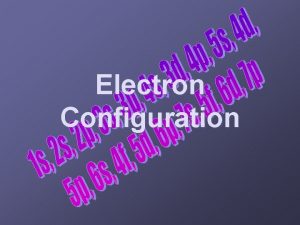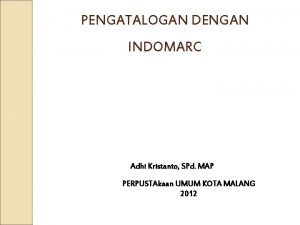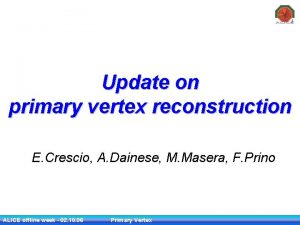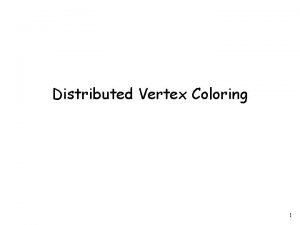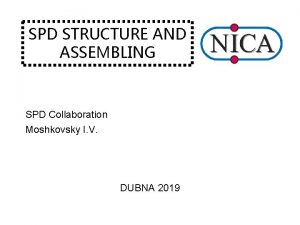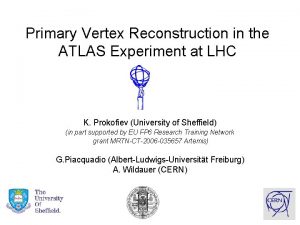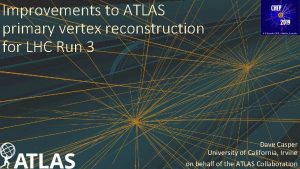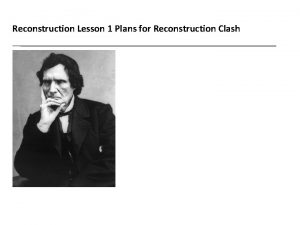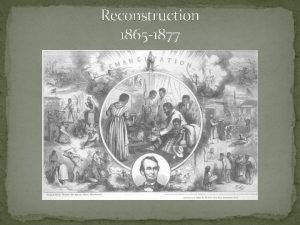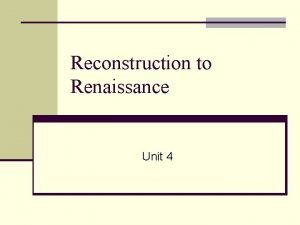Primary vertex reconstruction with the SPD E Crescio















- Slides: 15

Primary vertex reconstruction with the SPD E. Crescio, M. Masera, F. Prino INFN e Università di Torino Offline week, reconstruction meeting – October 2 nd 2006 1

Vertexers Ali. ITSVertexer. Z: uses information from SPD c Goals: high efficiency, constrain the tracking c Before tracking Ali. ITSVertexer 3 D: extension of Ali. ITSVertexer. Z to x and y c New class presently under test c Before tracking (needs just SPD tracklets) Ali. ITSVertexer. Ions: uses information from SPD c measurement of Xv, Yv, Zv through fit procedures c Not working for low multiplicities Ali. Vertexer. Tracks: uses tracks c Goals: accuracy and good error determination c Measurement of Xv, Yv, Zv c After recostruction in the barrel 2

Events used in this study Event generation c Ali. Root v 4 -04 -Release c pp collisions (k. Py. Mb) c Vertex smearing on x, y (50 m) and z (5. 3 cm) FIRST SET: c 9800 events with beam centered in 0, 0 SECOND SET: c 9400 events with beam centered in (500 m, 0) ONGOING GENERATION: c events with 5 mm and 1 cm of beam offset Vertexer. Z and Vertexer 3 D performance studied in 6 bins of Ntracklets in SPD (Ali. Multiplicity: : Get. Number. Of. Tracklets) c Efficiency = ratio between events with reconstructed vertex and total number of events c Residual distributions = distribution of zmeasured-ztrue ü Estract resolution, pulls and bias 3

Ali. ITSVertexer. Z – the method Layer 2 Build “tracklets” from SPD Rec. Points c associate each point of the two central SPD modules of layer 1 to all the points of layer 2 within a window Δφ <0. 01 rad Layer 1 Beam axis Calculate Zi = Z of closest approach of tracklet and nominal beam axis. Fill histograms of Zi with 3 different bin sizes c 5 m (fine: for the actual measure) c 100 m (coarse: to single out the peak corresponding to the actual vertex) c 300 m (very coarse: used when the number of tracklets is very low) Define a z window (200 or 600 m wide) around the “peak” of the coarse histogram. c Window adjusted to be symmetric around the centroid of the peak Calculate on the “fine” histogram: c Zv = average of the Zi of the tracklets in the window c Dispersion parameter (= sqrt of the sample variance) 4

Number of contributors Get. NContributors() to check the “quality” of the vertex c>0 Vertex OK c 0 error in the vertex finding procedure c-1 no tracklets ü recoverable with iterative procedure c-2 no recpoints in SPD 5

Performance: efficiency Black = beam in nominal position Red = beam offset 500 m – assumed unknown Blue = beam offset 500 m – assuming to know the beam position Optimized with an iterative procedure to reduce the fraction of events with no tracklets (NContributors=-1) 6 c. Committed on June 1 st (Ali. ITSVertexer. Z Rev 1. 11)

Performance: resolution and bias Black = beam in nominal position Red = beam offset 500 m – assumed unknown Blue = beam offset 500 m – assuming to know the beam position Bias reduced (from ≈20 to ≈5 m) since Rev. 1. 14 c Committed in HEAD, but not in v 4 -04 -Release Good performance for beam offset of 500 m if the offset is known 7

Peformance: pulls From distributions of Δz/Error cerror on the zmeasured as given by Ali. ITSVertexer. Z c. RMS of pull distributions should be 1 for gaussian estimators cto be checked at higher multiplicities 8

Vertexer 3 D – the method Pairs of Rec. Points on layer 1 and layer 2 taken as candidate tracklets c selection cut: Δφ <0. 01 rad (i. e. straight lines) Tracklet pairs are combined and selected according to: c small DCA c Intersection close to beam axis c Intersection in the diamond region tuning of these cuts presently under study Use tracklets as “straight-line-tracks” and apply the same vertex finder algorithms used with ESD tracks (Ali. Vertexer. Tracks) c Background tracklets must be removed as much as possible before applying the algorithm Layer 2 Layer 1 Beam axis 9

Vertexer 3 D - efficiency Overall efficiency ≈ 65% c. Efficiency improvements under study 10

Vertexer 3 D – bias and resolution Bias not present c Hint that the problem with the Vertexer. Z is in the vertexing algorithm and not in SPD geometry Good resolution! 11

Vertexer 3 D and beam offset Black = beam in nominal position Red = beam offset 500 m – assumed unknown Blue = beam offset 500 m – assuming to know the beam position Large bias on X (the coordinate where the beam has the offset) c ≈ 1/2 of the beam offset c Due to Δφ< 0. 01 rad selection cut (select straight lines pointing to the beam axis given as input) 12

Correcting the 3 D bias (I) First (very naïve) idea: iterative procedure c. For each event use x, y vertex positions found in iteration i as nominal beam positions for iteration i+1 c. Works sufficiently well for high multiplicity (i. e. good resolution) c. Price to pay: loss of resolution ü due to events with worse vertex determination at the 1 st iteration? c. May be recovered using nominal positions averaged over several high multiplicity events 13

Correcting the 3 D bias (II) Second (very naïve) idea: enlarge Δφ cut c From trigonometry: 500 m of offset give a max. Δφ of 0. 011 rad. c Does not allow to completely cancel the bias ü no improvement when enlarging Δφ from 0. 03 to 0. 05 c Price to pay: loss of resolution c Main drawback: requires huge enlargement in case of larger offsets Third idea (presently under development): change the tracklet selection c use a DCA cut between pairs of tracklets crossing the beam pipe instead of the Δφ cut 14

Pile-up Expected interaction rate = 2× 105 Hz at a luminosity of 5× 1030 cm-2 s-2 c 1 interaction every 200 bunch crossings Foreseen SPD strobe duration is 200 ns c 8 bunch crossings (0. 04 interactions) ü All events in the strobe are overlapped even if not belonging to the same bunch-cross Caveat: high- multiplicity triggers will select piled-up events First check on Ali. ITSVertexer. Z in the case of pile-up c “Manual merging” of recpoints with an “ad hoc” macro Results: c Vertices with distances >600 μm: found the vertex of the event with higher multiplicity c Vertices with distances <600 μm: found an intermediate value of z c Under study: check if the vertexer can be used to “detect” the pile-up, searching for two peaks (possible in the case of well separated peaks) Study to be performed also on the Vertexer 3 D 15
 What is the electron configuration of na+
What is the electron configuration of na+ Spd map
Spd map Spd bilddatenbank
Spd bilddatenbank Advanced protection technologies
Advanced protection technologies Spd 2
Spd 2 Các châu lục và đại dương trên thế giới
Các châu lục và đại dương trên thế giới Dot
Dot Nguyên nhân của sự mỏi cơ sinh 8
Nguyên nhân của sự mỏi cơ sinh 8 Bổ thể
Bổ thể độ dài liên kết
độ dài liên kết Thiếu nhi thế giới liên hoan
Thiếu nhi thế giới liên hoan điện thế nghỉ
điện thế nghỉ Alleluia hat len nguoi oi
Alleluia hat len nguoi oi Một số thể thơ truyền thống
Một số thể thơ truyền thống Trời xanh đây là của chúng ta thể thơ
Trời xanh đây là của chúng ta thể thơ Hệ hô hấp
Hệ hô hấp
